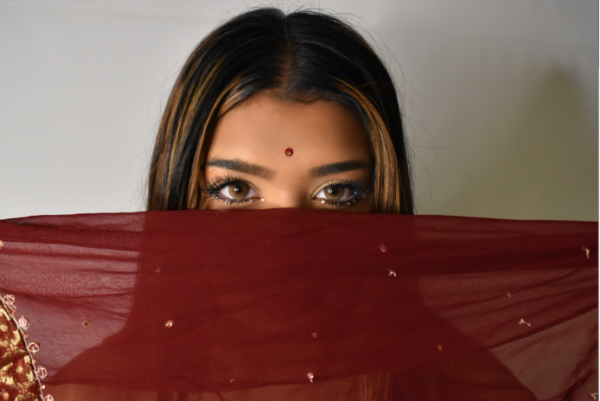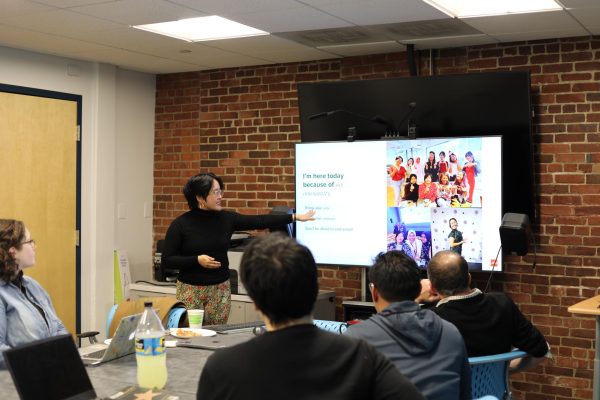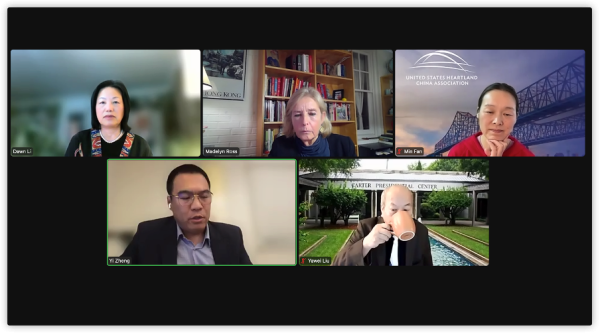Brazil’s young female entrepreneurs step up to create jobs
Yamê Villas (second from left) pictured alongside her mother, Yandara (left corner), and her two sisters, Mayra (second from right) and Thuany (right corner). Photo courtesy: Yamê Villas
April 30, 2020
Brazil has a high rate of unemployment and few job opportunities. But a new generation of young, female entrepreneurs and artists in the country are taking their future into their own hands by creating their own businesses.
A family business
Yamê Villas, 19, alongside her two sisters Thuany and Mayra, created GUYA, a jewelry and accessories brand , with the help of their parents who had experience in the market of fashion and accessories.
“From the start, we’ve done everything in the family. From the creation of the brand in a conversation at the dinner table to the making of the first pieces in our studio,” Yamê said.
The name of the business came from the combination of the parent’s names, Guto and Yandara.
Everything GUYA does is a team effort; each sister has a different but fundamental task. Yamê is in charge of the visual design; she pays attention to trends, organizes events and seeks new partnerships. Thuany works with the marketing and communication of the brand and Mayra works remotely in the technical part of their website.
“Our mom, Yandara, is the designer of the brand’s products. She is responsible for the production and is at the forefront of new collection developments,” Yamê said. “We try to divide and delegate [the tasks] as much as possible, but the big decisions are always debated and we take everyone’s opinion into account.”
Adapting to the coronavirus lockdown
Now, in times of crisis and the coronavirus, the brand is adapting. When the economy suffers, the price of gold and other jewelry materials rises and customers start to consume less.
“We are still adapting to the new coronavirus routine. We realized that, with the closing of schools and colleges, as well as the increase in the number of people working from home, consequently, people spend more time on the cell phone and internet,” Yamê said.
“We are currently investing in the production of content to help people get through quarantine, such as giving tips on recipes, exercises, meditation, movies, books, and even creating a playlist on Spotify,” she said.
The brand also created a promotional code “stayhome,” which can be used on their website, to encourage clients to stay inside and self-isolate.
Promoting arts through social media
Others have also turned to creating unique things. For friends Carolina Bonani and Maria Asfora, their futures started with art.
“Since 2016 I’ve noticed that everyone is trying to sell their thing, girls especially, selling jewelry, paintings, embroidery. I see a lot of girls doing all sorts of things,” Asfora said, “I think there comes a moment in people’s lives when we want to produce, not even just art, but we start wanting to do something. I started to want that when I was 15, that’s when I started with my Instagram [@mariavilhada].”
Asfora, 18, is part of the sudden influx of young female entrepreneurs that have started their own business or projects since around 2015. She focuses mostly on drawings that she makes on paper and later shares on her Instagram page, where people can admire or purchase them.
“It [art] is a form of rebellion, for those who do it and those who consume it. I think it’s really cool to see that there are people looking, people who want it, that seek me and my friends out for our art” Asfora said.

Asfora emphasized the importance of supporting local young artists and entrepreneurs. “Now more than ever, in such a difficult moment, whatever art people are producing, I want to support it,” Asfora said.
Although Asfora mainly focuses on drawings, she has explored other mediums of art. For a while, she made stickers with her designs to earn some extra money and she has recently started painting.
“I’m in more of a free process right now, I just start painting and sometimes I don’t even like what I paint. It’s an organic, everyday process, so I don’t lose my mind during quarantine,” Asfora said.
Difficulties posed by the lockdown
Asfora mentioned how, in quarantine, the biggest struggle for her is not the monotony of self-isolation but the lack of materials. “My [artist] friends are all painting, doing a lot of art. I don’t have any supplies right now, so it’s complicated. The art supply stores are all closed, so I can’t buy any materials,” she said.
For artist Carolina Bonani, 18, whose interest lies more on drawings, digital and graphic design, the quarantine has not been as much of a problem.
“At first I thought I wasn’t going to produce at all since I usually produce less when I am not in a routine. But wow, I’ve been creating a lot. I’ve been having online college classes and they really encourage me to create,” Bonani said.
Bonani is pursuing a degree in design at Pontifical Catholic University of Rio de Janeiro, but her interest in art started long before college. She said she first started drawing in high school, as a distraction during classes she found boring.
“I wanted to sleep in class but I couldn’t, so I started to draw. I didn’t have any technique, I just did them because I wanted time to go by faster. I ended up really liking it and wanting to learn more,” Bonani said.
Now, Bonani’s college classes inspire her to do work even in her free time. She started experimenting and doing collages on photoshop, which she said is her new passion.

Now in college, Bonani has indefinitely stopped selling, but she used to take commissions for her art. People used to ask her for caricatures and other specific drawings.
“The main reason why I started taking commissions was because I wanted some extra money,” Bonani said, “It was really cool at the time, in less than a month I made a good amount of money that I never thought I would just taking commissions.”
Aléxia Carvalho, 19, is another young Brazilian artist who started selling her work.
“I started selling my work to make money. I’d been living in Portugal for about five months and I needed to do something to accomplish what I really wanted, which was to travel,” Carvalho said, “I didn’t want to ask my parents for money, because I think that takes a bit of my freedom away. Selling my art was the way I found to make my own money, since I was still underage and couldn’t work.”
Carvalho currently lives in Portugal but when she first started selling her art, she made earrings and painted eco-friendly bags that she shipped over to Brazil. Now, she focuses mainly on her paintings and drawings.
“Art is something that I’m interested in because it’s our way of expression, I think it’s our way of putting things on paper that we can’t demonstrate or say out loud. That is what made me have this connection to art, because I am a person who has a lot of difficulty in speaking, in opening up,” Carvalho said.
Bringing young female entrepreneurs and artists together
Carvalho was the original creator of “Floresce,” which roughly translates to “Flourish,” an event and collective that brings multiple young female artists together. Bonani and Asfora were among the young creators that joined the group.
Although the event was originally planned for Portugal, Carvalho decided to hold it in Brazil during one of her trips back to her home country. She was working on personal exhibitions at the time but thought it would be interesting to expand her project.
“I thought it would be really cool to get other girls who are independent artists, like me, but who don’t have visibility yet. That was when I spoke to Maria [Asfora], and she instantly agreed. We talked to a bunch of other girls, presented the idea to them, and they agreed,” Carvalho said.
The event is a place where various female creators can share their work and exhibit their art. Girls sell their drawings, paintings, vegan food they make, offer tattoo services and even perform songs and dances.

“The idea of the collective has always been to give visibility to women,” Carvalho said, “Women are hardly ever seen as artists, they are usually seen as muses for others to paint. If you look at the history of women in art, the history is minimal. I think it is more important every day to deal with the desexualization of women in the artistic field. Women also have a voice.”
The event in Rio de Janeiro was a success. “It exceeded all of my expectations, so many people went. I’m really thankful to Maria for inviting me. It was incredible,” Bonani said.
The importance of arts in the age of quarantine
Carvalho now plans to execute the event in Lisbon, Portugal, where she has already gathered a group of girls that are deeply involved with the project.
In the new age of quarantine, Carvalho said self-isolation has allowed her to focus more on her art and well-being. She has been highlighting the importance of art in hard times by using the hashtag #artintimesofcrisis when she posts her work.
During this period of quarantine, when there is an increase in consumption of television shows, music and videos on social media worldwide, Carvalho said she noticed there are more talks about the importance of art.
“Art is in everything, but people don’t appreciate it, they only appreciate it when they lose access to things and they find themselves needing to rely on something, which was art, in this case,” Carvalho said, “I hope after everything is better, that people can keep appreciating art and supporting it like they [are] now.”











